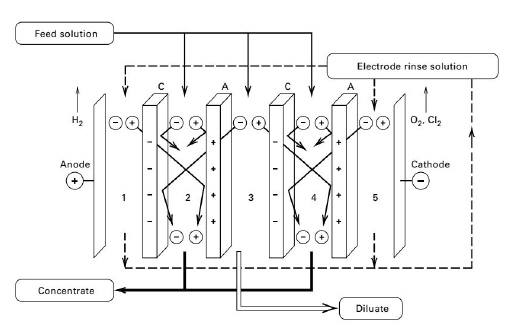
Electrodialysis refers to an electrolytic process for separating an aqueous, electrolyte feed into a concentrate and a diluate stream by using an electric field and ion-selective membranes. These membranes allow the selective migration of ions while retaining water molecules. The driving force for the ion transport is the difference in free energy between the high saline and low saline solutions. The transport will continue until an equilibrium is reached where the chemical potential of salts is equal.

Electrodialysis processes are different from other membrane based processes, such as reverse osmosis (RO, in that dissolved species are moved away from the feed stream rather than the reverse. The major application of electrodialysis has historically been the desalination of brackish water or seawater as an alternative to RO for potable water production and seawater concentration for salt production. In normal potable water production, RO is generally considered to be more cost-effective when total dissolved solids (TDS) are 3000 parts per million (ppm) or greater, while electrodialysis is more cost-effective for TDS concentrations less than 3000 ppm or when high recoveries of the feed are required.
A typical electrodialysis process is shown in the figure below. The ion-selective membranes are of two types arranged in an alternating-series pattern. The negatively-charged cation-selective membranes (C) attract and allow passage of the positively charged ions (cations) but block the passage of negative ions (anions). Conversely, the anion-selective membranes (A) carry a positive charge that attracts and permits passage of anions. As a result, both anions and cations are concentrated in compartments 2 and 4, from which concentrate is withdrawn, and ions are depleted in compartment 3, from which the diluate is withdrawn.
A direct-current voltage causes current to flow through the cell by ionic conduction from the cathode to the anode. Both electrodes are chemically neutral metals, with the anode typically being made of stainless steel and the cathode of platinum-coated tantalum, niobium, or titanium to prevent oxidization and reduction.Unit Procedure Availability
In Design Mode, the user must specify the removal percentage of components that are absorbed and the program will calculate the required membrane area based on the percentage of the design component (see ‘Equipment Sizing’ below). In Rating Mode, the user specifies the membrane area available and SuperPro will estimate the corresponding removal percentage of the design component, taking into account the removal percentages of the other components.
The electrodialysis sizing model employed by SuperPro is based on Faraday’s law. Specifically, the membrane area, AM, is estimated by the current density as shown in the equation below:
|
|
where F is the Faraday constant (96520 A-s/equivalent), Q is volumetric flowrate of the diluate (m3/s), zj is the ion charge (valence) of component j, ΔCj is the concentration difference of component j between the feed and the diluate streams (mol/m3), i is the current density of a cell pair (A/m2) and ξ is the current efficiency. The efficiency accounts for the fact that not all of the current is effective in transporting ions through the membranes.
The power consumption, P, is given by:
|
|
eq. (A.101) |
where I is the electric current flow and E is the voltage across the stack. The electric current flow I is equal to:
|
|
where n is the number of cell pairs. By combining eq. (A.100) and eq. (A.102):
|
|
eq. (A.103) |
The cost associated with the periodic replacement of membranes contributes to cost of Consumables. This cost is calculated based on the replacement frequency (in Operating Hours or Number of Cycles), the membrane unit cost (in $/m2), and the filtration time (specified by the user or calculated by the program).
1. J. D. Seader, Ernest J. Henley and D. Keith Roper (2010). Separation Process Pronciples - Chemical and Biochemical Operations, John Wiley & Sons, Inc.
The interface of this operation has the following tabs:
● Oper. Cond’s, see Electrodialysis: Oper. Conds Tab
● Labor, etc, see Operations Dialog: Labor etc. Tab
● Description, see Operations Dialog: Description Tab